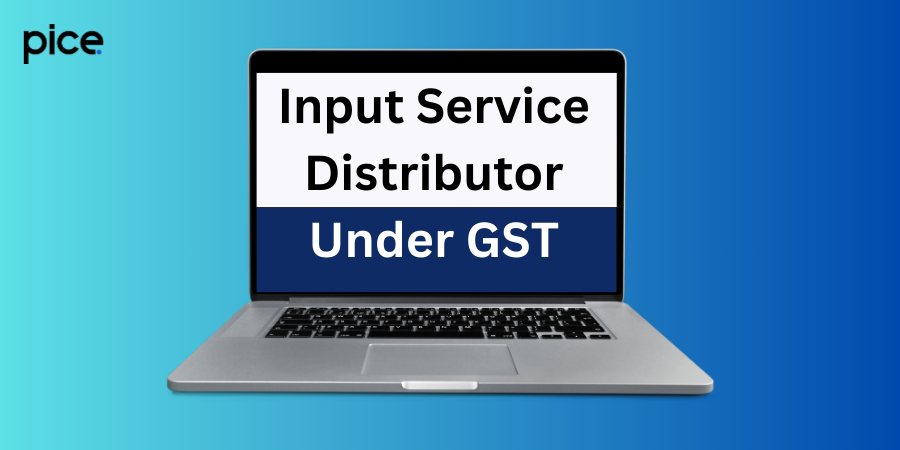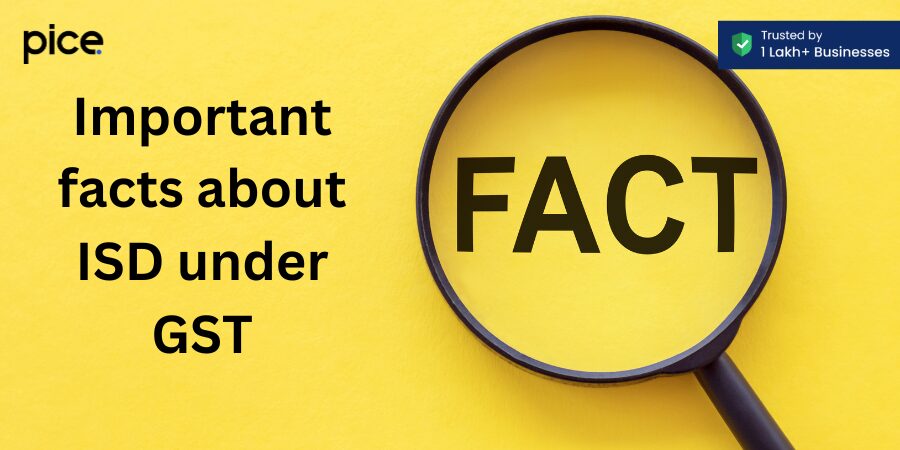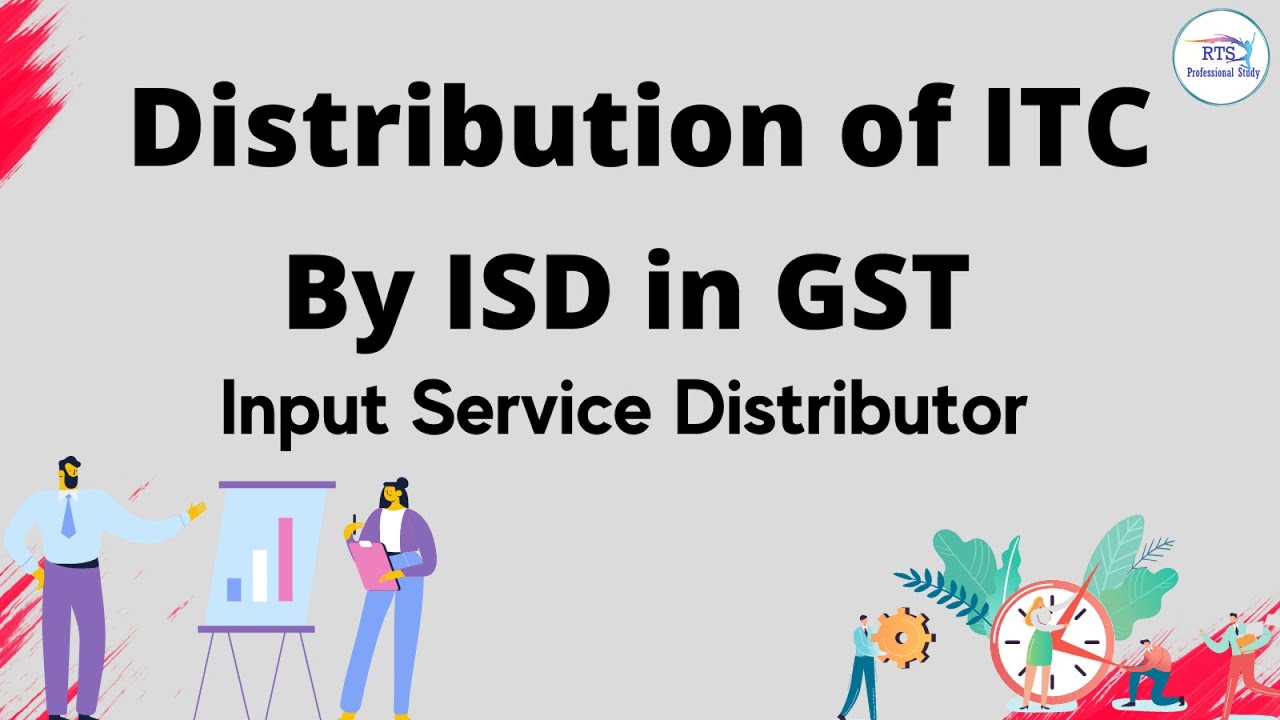Input Service Distributor (ISD) under GST
- 23 Aug 24
- 11 mins

Input Service Distributor (ISD) under GST
- Defining Input Service Distributor under GST
- Important facts about ISD under GST
- What is the need for Input Service Distributor?
- Registration Procedure for ISD
- ITC rules for Input Service Distributor
- How to determine ITC Ratio for Input Service Distribution
- How to issue an ISD Invoice
- How to calculate ITC for Input Service Distribution
Key Takeaway
- An Input Service Distributor (ISD) under GST is responsible for distributing input tax credit to various branches or units of the same entity, ensuring efficient utilization of the credit.
- Only eligible input tax credit can be distributed by an ISD, while ineligible credit related to exempt supplies or personal use must be excluded from the distribution.
- The distribution of tax credit must be done on a pro-rata basis based on the turnover ratio of each branch to the aggregate turnover of all branches.
- Proper documentation, including the issuance of ISD invoices and the filing of form GSTR-6, is crucial for maintaining compliance and ensuring accurate distribution of input tax credit.
- The due date for filing form GSTR-6 is the 13th of the calendar month following the relevant tax period, ensuring timely and accurate reporting of distributed credit.
Defining Input Service Distributor under GST
An Input Service Distributor (ISD) under the Goods and Services Tax (GST) regime is an office of the supplier of goods or services that receives tax invoices for input services and issues a tax invoice for the purpose of distributing the credit of tax paid (input tax credit) to branches or units of the same entity. The ISD mechanism is designed to ensure the smooth flow of credit within an organization, allowing businesses to utilize the benefits of input tax credit across different branches. This is especially useful for businesses with common expenditures incurred at a central level but utilized across various locations.
The ISD is responsible for the distribution of credit under GST, including the distribution of input tax credit related to the reverse charge mechanism. It is crucial for the ISD to maintain proper documentation, such as tax invoices and credit notes, to ensure accurate distribution of input tax credit. The distributed credit must align with the respective branch's turnover ratio, ensuring fair and proportional allocation of eligible input tax credit. This system facilitates the efficient credit-taking process and compliance with GST regulations, helping businesses optimize their tax liabilities.
Important facts about ISD under GST

- Eligibility: Any office of a taxable person that receives invoices for input services and intends to distribute the input tax credit to different units of the same entity can register as an ISD.
- No Cross-Entity Distribution: The ISD can only distribute input tax credit to units having the same Permanent Account Number (PAN) as the ISD itself. Cross-entity distribution is not permitted.
- Nature of Credit: The input tax credit distributed can include CGST, SGST, and IGST. However, the distribution must be done in accordance with the type of credit received.
- Pro-rata Distribution: The distribution of input tax credit must be done on a pro-rata basis, considering the turnover ratio of each unit to the aggregate of turnover of all units during the relevant period.
- Documentation: The ISD must issue a tax invoice or a credit note for distributing the credit. The details of these documents should be reflected in the GSTR-2B Return of the respective recipients.
- ITC Eligibility: Only eligible input tax credit can be distributed. Any ineligible input tax credit must be excluded from the distribution process.
- Compliance: The ISD must comply with the annual returns filing requirements and ensure that all credits distributed are accurately reported and reconciled with the GSTR-2B Returns of the receiving units.
💡If you want to pay your GST with Credit Card, then download Pice Business Payment App. Pice is the one stop app for all paying all your business expenses.
What is the need for Input Service Distributor?
The need for an Input Service Distributor (ISD) arises from the necessity to streamline and optimize the utilization of input tax credit within large organizations with multiple branches or units. Here's why ISD is essential:
- Centralized Expenditure: Large organizations often incur common expenditures such as marketing, administration, and training at a central level. The ISD mechanism allows for the efficient distribution of input tax credit from these centralized expenditures to the respective branches.
- Enhanced Cash Flow: By distributing the input tax credit, branches can reduce their GST liabilities, improving their cash flow. This ensures that credit of tax paid is effectively utilized where it is needed most.
- Simplified Compliance: The ISD mechanism simplifies the GST compliance process for businesses with multiple locations. It ensures that the credit-taking process is streamlined and aligned with GST regulations.
- Avoiding Redundancies: Without the ISD mechanism, branches would individually claim input tax credit, leading to redundancies and complexities in the flow of credit. ISD centralizes this process, making it more efficient.
- Proportional Credit Allocation: The ISD ensures that the distribution of input tax credit is done on a proportional basis, based on the turnover ratio of each branch. This fair allocation helps in maintaining transparency and accuracy in credit distribution.
- Regulatory Adherence: The ISD mechanism is a regulatory requirement under GST for businesses that need to distribute input tax credit. Adhering to this ensures compliance and avoids any legal issues related to GST credit claims.
Registration Procedure for ISD

Step 1: Access the GST portal
Visit the GST portal and log in using your credentials. Navigate to the "Services" section and select "Registration" followed by "New Registration."
Step 2: Complete the required details
Fill in the required details such as legal name of the business, PAN, email address, and mobile number. Ensure all information is accurate to avoid any delays in the registration process.
Step 3: Provide the Principal Place of Business
Enter the principal place of business, including the address, contact details, and nature of premises. This is where the ISD will primarily operate.
Step 4: Provide additional details
Include additional information such as bank account details and details of goods and services provided. This helps in verifying the business and ensuring proper registration.
Step 5: Enter the authorized signatory details
Provide details of the authorized signatory, including their name, designation, and contact information. The authorized signatory will be responsible for managing the ISD's GST compliance.
Step 6: Verify the application
Review all the information entered and verify the application using either an Electronic Verification Code (EVC) or a Digital Signature Certificate (DSC).
Step 7: Obtain the Application Reference Number (ARN)
Upon successful submission, an Application Reference Number (ARN) will be generated. Use this ARN to track the status of your registration application.
ITC rules for Input Service Distributor
The Input Tax Credit (ITC) rules for Input Service Distributors (ISD) under GST are designed to ensure the proper distribution of credit across various branches of a business. Here are key ITC rules for ISDs:
- Proportional Distribution: ISDs must distribute the input tax credit proportionally based on the turnover ratio of each branch to the aggregate of turnover of all branches during the relevant month.
- Eligible and Ineligible ITC: Only eligible input tax credit can be distributed. Any ineligible input tax credit, such as those related to exempt supplies or personal use, must be excluded from the distribution process.
- Type of Credit: The ISD must distribute the credit of tax paid in the same nature as it was received. For example, CGST credit must be distributed as CGST credit, and IGST credit as IGST credit.
- Documentation: ISDs must issue an ISD invoice or credit note for distributing the credit. This ensures proper documentation and traceability of the distributed credit.
- Reporting in Returns: The distributed credit must be reported in the GSTR-6 return filed by the ISD. The respective branches will reflect the received credit in their GSTR-2B Returns.
- Reverse Charge Mechanism: ITC related to supplies under the reverse charge mechanism can also be distributed by the ISD, provided it is correctly documented and reported.
How to determine ITC Ratio for Input Service Distribution
Determining the ITC ratio for input service distribution involves calculating the turnover ratio of each branch to the aggregate turnover of all branches. Here’s how to determine it:
- Identify Total Turnover: Calculate the total turnover for each branch for the relevant month. This includes all outward supplies, both taxable and exempt.
- Aggregate Turnover: Sum the turnovers of all branches to get the aggregate turnover.
- Calculate Ratio: Determine the turnover ratio for each branch by dividing the individual branch turnover by the aggregate turnover. This ratio will be used to proportionally distribute the input tax credit.
- Pro-rata Basis: The input tax credit received by the ISD is distributed to each branch on a pro-rata basis, based on the calculated turnover ratios.
- Adjustments for Exempt Supplies: If any branch has exempt supplies, adjust the ratios to ensure that ineligible input tax credit is not distributed.
- Monthly Review: Recalculate the turnover ratios every month to ensure accurate and up-to-date distribution of input tax credit.
How to issue an ISD Invoice
Issuing an ISD invoice involves the following steps:
- Invoice Number: Assign a unique invoice number to each ISD invoice, following a sequential order.
- Details of ISD: Include the name, address, and GSTIN of the ISD.
- Recipient Details: Mention the name, address, and GSTIN of the branch receiving the credit.
- Original Invoice Reference: Refer to the original invoice under which the input tax credit was received.
- Credit Amount: Specify the amount of input tax credit being distributed, broken down into CGST, SGST, and IGST.
- Date of Issue: Include the date on which the ISD invoice is issued.
How to calculate ITC for Input Service Distribution

Calculating ITC for input service distribution involves the following steps:
- Identify Eligible ITC: Determine the total eligible input tax credit available for distribution, excluding any ineligible ITC.
- Determine Turnover Ratios: Calculate the turnover ratios for each branch as described in the previous section.
- Proportional Allocation: Allocate the input tax credit to each branch based on the turnover ratios. Ensure the distribution is done on a pro-rata basis.
- Document Issuance: Issue ISD invoices to each branch with the allocated credit amounts.
- Reporting: Report the distributed credit in the GSTR-6 return filed by the ISD. Branches should reflect the received credit in their GSTR-2B Returns.
- Review and Adjust: Regularly review and adjust the distribution process to ensure compliance with ITC rules and proper credit allocation.



















